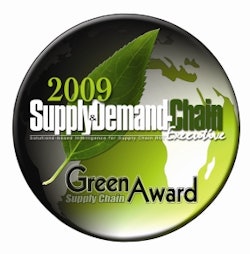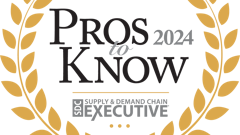
By the Editors of Supply & Demand Chain Executive
The convergence of public pressure, government regulations and corporate social responsibility initiatives is driving increasing numbers of organizations to view "green" and "sustainability" as necessary components of their supply chain strategies. To a great degree, sustainability has become a "must have" for increasing numbers of companies.
This year Supply & Demand Chain Executive again is recognizing companies that are taking steps to realize green goals with our 2009 Green Supply Chain Awards. This year's edition of the awards saw more than more than 70 submissions. From among the nominated companies our review panel selected those that stood out for their projects to incorporate sustainability objectives into their own supply chains or to enable sustainability in their customers' supply chain.
The recipients of the 2009 Green Supply Chain Awards are listed below, along with summaries of their projects.
Adopting a Proactive Strategy
Schneider Electric (Rueil-Malmaison, France, www.schneider-electric.com). Schneider Electric is a global specialist in energy management, with operations in more than 100 countries. The company has focused on sustainability at the enterprise level as part of its commitment to corporate social responsibility. However, Schneider Electric also has linked sustainability to its supply chain strategy and has adopted a proactive approach to ensuring compliance with environmental regulations and to managing the supply risks and opportunities associated with those regulations.
As an example, Alain Digeon, senior vice president, globalization and industry, Environment Projects, at Schneider Electric, points to REACH — the E.U.'s Registration, Evaluation, Authorization and restriction of Chemical substances legislation, which already is having a major impact on global supply chains across industry sectors and geographies. REACH imposes a reporting burden on companies, which must be prepared to proactively notify downstream users regarding the presence of a growing list of hazardous chemicals in their products and respond to consumer requests for information on the presence of those chemicals within 45 days
Notification is a requirement under REACH. But Digeon also believes that implementing a REACH strategy can help a company reinforce its relationships with its customers if the company can respond to customer information requests in a timely manner, or if the company can help customers understand aspects of REACH that they may have overlooked. "We want to facilitate the lives of our customers and of their customers, and in that context complying with laws and standards is a major step in that direction," Digeon says.
For more information on Schneider Electric's strategy to mitigate potential supply chain disruptions caused by an increasing number of regulatory mandates, go to page 7 in the October 2000 e-book issue of Supply & Demand Chain Executive.
Taking an End-to-end Approach
AMD Corporation (Santa Clara, Calif., www.amd.com). Forty-year-old chip maker AMD marked 2009 with the publication of its ninth annual Global Climate Protection Plan in August, which included an update on the company's efforts, begun last year, to track Scope 3 greenhouse gas emissions. Scope 3 emissions include all indirect emissions (other than from purchased electricity) that occur from sources that are not owned or controlled by the company, covering outsourced manufacturing operations and other suppliers' operations, as well as transportation- and logistics-related emissions. The move sets the stage for AMD to gain greater visibility into the carbon footprint of its end-to-end supply chain, and provides a foundation for working more closely with suppliers around metrics, goals and strategy to limit that footprint.
Finding Efficiency in Green
Conexant Systems, Inc. (Newport Beach, Calif., www.conexant.com). Becoming green has meant focusing internally for Conexant Systems, which develops and manufactures semiconductor solutions for imaging applications, audio solutions, embedded modems and video solutions. And it also has meant supporting customers' goals, according to Sailesh Chittipeddi, co-president of the company. "For us, becoming green has meant looking at every aspect of our operations and how we make it more efficient," Chittipeddi says. "That means looking at all our own activities, while also supporting our customer base, which is very 'eco-demanding,' if you will." In one move, for example, Conexant Systems consolidated its hubs to two major locations in Singapore and Taiwan, allowing it to mix-and-match its chip sets at those locations, providing for significant reduction and reuse of packing materials, while also reducing customer shipment frequency by 75 percent.
Extending Green into the Supply Chain
Hewlett-Packard Company (Palo Alto, Calif., www.hp.com). HP stakes a claim as the world's largest IT company, operating the largest supply chain in the technology industry. The roots of the company's sustainable supply chain program stretches back to 1992, when it launched its Design for Environment (DfE) program. Today, the company has extended its sustainability efforts into its supply chains, requiring suppliers to meet HP's own stringent environmental expectations, regardless of where they operate. "We have a responsibility to lead in this area that we take very seriously," the company says. "It is consistent with our core values to be a force for positive change in the communities where we work and live. We ask our suppliers to make the same commitment and work closely with them to help them succeed."
Fulfilling a Long-term Vision
Interface, Inc. (Atlanta, www.interfaceglobal.com). Interface's green supply chain goals have evolved out of a greater commitment to sustainability that started in the mid-1990s. Interface's Chairman and CEO Ray C. Anderson shifted the company's strategy, aiming to redirect its industrial practices to include a focus on sustainability without sacrificing its business goals. In 1994, Interface, Inc. defined its vision "to be the first company that by its deeds shows the entire industrial world what sustainability is in all its dimensions: people, process, product, place and profits, by 2020 and in doing so will become restorative through the power of influence." Today, this is simply referred to as "Mission Zero," the company's pledge to eliminate any negative impact it may have on the environment by the year 2020.
Bringing Green to Retail
Williams-Sonoma (San Francisco, www.williams-sonomainc.com). Williams-Sonoma is committed to ethical sourcing and environmental stewardship throughout the supply chain. The company's commitment to responsible wood sourcing is backed up by membership in the Global Forest & Trade Network, the World Wildlife Fund's initiative to save the world's most valuable and threatened forests. Williams-Sonoma's wood and paper-products procurement policy documents the company's standards and commitment to these goals. With these goals in place, Williams-Sonoma, to date, has incorporated recycled paper into packaging and publications. For example, shipping cartons incorporate 30 percent post-consumer waste paper (PCW). The flagship Williams-Sonoma catalog has incorporated 10 percent PCW since 2004, and in-store collateral ranges from 30 percent - 100 percent PCW.
2009 Green Supply Chain Awards: Enablers
ATC Logistics & Electronics (www.atcle.com). Established advanced supply chain processes to help customers maximize the lifespan of their products, or as a last resort, manage recycling opportunities, to reduce waste.
CaseStack (www.casestack.com). CaseStack's Green Carriers Program gives customers the ability to choose carriers who utilize sustainable features.
DSC Logistics (www.dsclogistics.com). In its Sustainability Statement of Purpose, DSC pledges to adopt practices that promote the responsible use of resources throughout the organization; work with customers to support and realize the value of sustainability initiatives; and encourage employees to think greener in all aspects of their lives.
D.W. Morgan Company (www.dwmorgan.com). At D.W. Morgan Co., the paper way bill has gone the way of the dodo bird. With the roll-out of its iPhone-based mobile communications system, the supply chain management and transportation logistics services firm estimates it has helped eliminate roughly 50,000 paper way bills annually.
Global4PL (www.global-4pl.com). Offers a free Green Supply Assessment and has assisted various customers in China and Hong Kong set up Green programs that involve measuring and then reducing greenhouse gas emissions.
IHS (www.ihs.com). Provides information and insights to enable greening the supply chain across the range of functions in the enterprise, including carbon and GHG management; material safety data sheet (MSDS) and chemical lifecycle management; air, water and waste data management; sustainability tracking, management and reporting; regulatory compliance management; REACH, RoHS and product stewardship/eco-design enablement; and chemical supply chain greening.
INSIGHT, Inc. (www.insightoutsmart.com). Allows companies to study the environmental impact of their supply chain processes and has added byproducts to its modeling capability.
Integration Point (www.IntegrationPoint.com). Assists clients in meeting green supply chain goals through capabilities in its Supply Chain Compliance solution that allow for tracking partners' adherence to social and environmental responsibility practices.
Ivalua Inc. (www.ivalua.com). Works with an ecosystem of green supply chain consultants, NGOs and customers to put in place the foundations of successful green projects.
JIT Reshippables, Inc. (www.jitreshippables.com). JIT Reshippables' customers are replacing expendable packaging with reusable plastic packaging, reducing packaging waste to zero. JIT Reshippables tracks all its plastic reusable packaging throughout its customers' closed loop supply chains to eliminate lost containers.
ModusLink Global Solutions (www.moduslink.com). ModusLink's Sustainable Solutions Suite is designed to help supply chain practitioners minimize the environmental impact of their processes and reduce total costs, including through optimized configuration, sustainable packaging design and GHG footprinting, among other services.
Optiant (www.optiant.com). Companies use Optiant's PowerChain Inventory, Planner and Network Design solution to improve efficiencies within their operations that lead to lower carbon footprints, reduced energy usage and optimal usage of warehouse/DC space.
SciQuest, Inc. (www.sciQuest.com). SciQuest encourages the selection of sustainable suppliers through a green procurement classification system that clearly identifies green suppliers within search results, helping buyer more effectively target sustainable suppliers.
SigmaQuest (www.sigmaquest.com). Helps companies find, fix and avoid quality issues through the supply chain, enabling significant reduction in scrap, in addition to reducing customer returns.
SYSPRO (www.syspro.com). SYSPRO stakes a claim as one of the first ERP companies to pioneer a green solution, and today offers "Project Green Enable," a collection of capabilities now inherent in the company's enterprise software solution and focused around energy efficiency, waste reduction and recyclable/re-use of resources.
Enabling Green Logistics
Eliminating Paper in the Supply Chain
The convergence of public pressure, government regulations and corporate social responsibility initiatives is driving increasing numbers of organizations to view "green" and "sustainability" as necessary components of their supply chain strategies. To a great degree, sustainability has become a "must have" for increasing numbers of companies.
This year Supply & Demand Chain Executive again is recognizing companies that are taking steps to realize green goals with our 2009 Green Supply Chain Awards. This year's edition of the awards saw more than more than 70 submissions. From among the nominated companies our review panel selected those that stood out for their projects to incorporate sustainability objectives into their own supply chains or to enable sustainability in their customers' supply chain.
The recipients of the 2009 Green Supply Chain Awards are listed below, along with summaries of their projects.
Adopting a Proactive Strategy
Schneider Electric (Rueil-Malmaison, France, www.schneider-electric.com). Schneider Electric is a global specialist in energy management, with operations in more than 100 countries. The company has focused on sustainability at the enterprise level as part of its commitment to corporate social responsibility. However, Schneider Electric also has linked sustainability to its supply chain strategy and has adopted a proactive approach to ensuring compliance with environmental regulations and to managing the supply risks and opportunities associated with those regulations.
As an example, Alain Digeon, senior vice president, globalization and industry, Environment Projects, at Schneider Electric, points to REACH — the E.U.'s Registration, Evaluation, Authorization and restriction of Chemical substances legislation, which already is having a major impact on global supply chains across industry sectors and geographies. REACH imposes a reporting burden on companies, which must be prepared to proactively notify downstream users regarding the presence of a growing list of hazardous chemicals in their products and respond to consumer requests for information on the presence of those chemicals within 45 days
Notification is a requirement under REACH. But Digeon also believes that implementing a REACH strategy can help a company reinforce its relationships with its customers if the company can respond to customer information requests in a timely manner, or if the company can help customers understand aspects of REACH that they may have overlooked. "We want to facilitate the lives of our customers and of their customers, and in that context complying with laws and standards is a major step in that direction," Digeon says.
For more information on Schneider Electric's strategy to mitigate potential supply chain disruptions caused by an increasing number of regulatory mandates, go to page 7 in the October 2000 e-book issue of Supply & Demand Chain Executive.
Taking an End-to-end Approach
AMD Corporation (Santa Clara, Calif., www.amd.com). Forty-year-old chip maker AMD marked 2009 with the publication of its ninth annual Global Climate Protection Plan in August, which included an update on the company's efforts, begun last year, to track Scope 3 greenhouse gas emissions. Scope 3 emissions include all indirect emissions (other than from purchased electricity) that occur from sources that are not owned or controlled by the company, covering outsourced manufacturing operations and other suppliers' operations, as well as transportation- and logistics-related emissions. The move sets the stage for AMD to gain greater visibility into the carbon footprint of its end-to-end supply chain, and provides a foundation for working more closely with suppliers around metrics, goals and strategy to limit that footprint.
Finding Efficiency in Green
Conexant Systems, Inc. (Newport Beach, Calif., www.conexant.com). Becoming green has meant focusing internally for Conexant Systems, which develops and manufactures semiconductor solutions for imaging applications, audio solutions, embedded modems and video solutions. And it also has meant supporting customers' goals, according to Sailesh Chittipeddi, co-president of the company. "For us, becoming green has meant looking at every aspect of our operations and how we make it more efficient," Chittipeddi says. "That means looking at all our own activities, while also supporting our customer base, which is very 'eco-demanding,' if you will." In one move, for example, Conexant Systems consolidated its hubs to two major locations in Singapore and Taiwan, allowing it to mix-and-match its chip sets at those locations, providing for significant reduction and reuse of packing materials, while also reducing customer shipment frequency by 75 percent.
Extending Green into the Supply Chain
Hewlett-Packard Company (Palo Alto, Calif., www.hp.com). HP stakes a claim as the world's largest IT company, operating the largest supply chain in the technology industry. The roots of the company's sustainable supply chain program stretches back to 1992, when it launched its Design for Environment (DfE) program. Today, the company has extended its sustainability efforts into its supply chains, requiring suppliers to meet HP's own stringent environmental expectations, regardless of where they operate. "We have a responsibility to lead in this area that we take very seriously," the company says. "It is consistent with our core values to be a force for positive change in the communities where we work and live. We ask our suppliers to make the same commitment and work closely with them to help them succeed."
Fulfilling a Long-term Vision
Interface, Inc. (Atlanta, www.interfaceglobal.com). Interface's green supply chain goals have evolved out of a greater commitment to sustainability that started in the mid-1990s. Interface's Chairman and CEO Ray C. Anderson shifted the company's strategy, aiming to redirect its industrial practices to include a focus on sustainability without sacrificing its business goals. In 1994, Interface, Inc. defined its vision "to be the first company that by its deeds shows the entire industrial world what sustainability is in all its dimensions: people, process, product, place and profits, by 2020 and in doing so will become restorative through the power of influence." Today, this is simply referred to as "Mission Zero," the company's pledge to eliminate any negative impact it may have on the environment by the year 2020.
Bringing Green to Retail
Williams-Sonoma (San Francisco, www.williams-sonomainc.com). Williams-Sonoma is committed to ethical sourcing and environmental stewardship throughout the supply chain. The company's commitment to responsible wood sourcing is backed up by membership in the Global Forest & Trade Network, the World Wildlife Fund's initiative to save the world's most valuable and threatened forests. Williams-Sonoma's wood and paper-products procurement policy documents the company's standards and commitment to these goals. With these goals in place, Williams-Sonoma, to date, has incorporated recycled paper into packaging and publications. For example, shipping cartons incorporate 30 percent post-consumer waste paper (PCW). The flagship Williams-Sonoma catalog has incorporated 10 percent PCW since 2004, and in-store collateral ranges from 30 percent - 100 percent PCW.
2009 Green Supply Chain Awards: Enablers
ATC Logistics & Electronics (www.atcle.com). Established advanced supply chain processes to help customers maximize the lifespan of their products, or as a last resort, manage recycling opportunities, to reduce waste.
CaseStack (www.casestack.com). CaseStack's Green Carriers Program gives customers the ability to choose carriers who utilize sustainable features.
DSC Logistics (www.dsclogistics.com). In its Sustainability Statement of Purpose, DSC pledges to adopt practices that promote the responsible use of resources throughout the organization; work with customers to support and realize the value of sustainability initiatives; and encourage employees to think greener in all aspects of their lives.
D.W. Morgan Company (www.dwmorgan.com). At D.W. Morgan Co., the paper way bill has gone the way of the dodo bird. With the roll-out of its iPhone-based mobile communications system, the supply chain management and transportation logistics services firm estimates it has helped eliminate roughly 50,000 paper way bills annually.
Global4PL (www.global-4pl.com). Offers a free Green Supply Assessment and has assisted various customers in China and Hong Kong set up Green programs that involve measuring and then reducing greenhouse gas emissions.
IHS (www.ihs.com). Provides information and insights to enable greening the supply chain across the range of functions in the enterprise, including carbon and GHG management; material safety data sheet (MSDS) and chemical lifecycle management; air, water and waste data management; sustainability tracking, management and reporting; regulatory compliance management; REACH, RoHS and product stewardship/eco-design enablement; and chemical supply chain greening.
INSIGHT, Inc. (www.insightoutsmart.com). Allows companies to study the environmental impact of their supply chain processes and has added byproducts to its modeling capability.
Integration Point (www.IntegrationPoint.com). Assists clients in meeting green supply chain goals through capabilities in its Supply Chain Compliance solution that allow for tracking partners' adherence to social and environmental responsibility practices.
Ivalua Inc. (www.ivalua.com). Works with an ecosystem of green supply chain consultants, NGOs and customers to put in place the foundations of successful green projects.
JIT Reshippables, Inc. (www.jitreshippables.com). JIT Reshippables' customers are replacing expendable packaging with reusable plastic packaging, reducing packaging waste to zero. JIT Reshippables tracks all its plastic reusable packaging throughout its customers' closed loop supply chains to eliminate lost containers.
ModusLink Global Solutions (www.moduslink.com). ModusLink's Sustainable Solutions Suite is designed to help supply chain practitioners minimize the environmental impact of their processes and reduce total costs, including through optimized configuration, sustainable packaging design and GHG footprinting, among other services.
Optiant (www.optiant.com). Companies use Optiant's PowerChain Inventory, Planner and Network Design solution to improve efficiencies within their operations that lead to lower carbon footprints, reduced energy usage and optimal usage of warehouse/DC space.
SciQuest, Inc. (www.sciQuest.com). SciQuest encourages the selection of sustainable suppliers through a green procurement classification system that clearly identifies green suppliers within search results, helping buyer more effectively target sustainable suppliers.
SigmaQuest (www.sigmaquest.com). Helps companies find, fix and avoid quality issues through the supply chain, enabling significant reduction in scrap, in addition to reducing customer returns.
SYSPRO (www.syspro.com). SYSPRO stakes a claim as one of the first ERP companies to pioneer a green solution, and today offers "Project Green Enable," a collection of capabilities now inherent in the company's enterprise software solution and focused around energy efficiency, waste reduction and recyclable/re-use of resources.
Enabling Green Logistics
- Con-way Inc. (www.con-way.com)
- Container and Pooling Solutions (www.UseCAPS.com)
- The Evans Network of Companies (www.evansdelivery.com)
- Flash Global Logistics (www.flashgloballogistics.com)
- Ryder (www.ryder.com)
- Strive Logistics, LLC (www.strivelogistics.com)
- Total Logistic Control (www.totallogistic.com)
- Transplace (www.transplace.com)
- UPS (www.ups.com)
Eliminating Paper in the Supply Chain
- Cass Information Systems, Inc. (www.cassinfo.com)
- SmartTurn (www.smartturn.com)
- Transzap, Inc. (www.transzap.com)

























